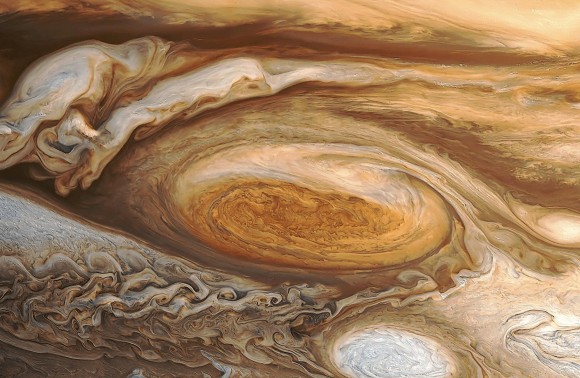Jupiter’s Great Red Spot- a huge storm in Jupiter’s atmosphere- has been ongoing for seemingly as long as people have pointed their telescopes toward the planet; this means that the storm has continued for at least approximately 400 years, and most likely more. The storm itself is twice Earth’s size. It is known that storms on Jupiter are significantly more intense than storms on Earth. This can be explained by the fact that since Jupiter’s surface consists of a “liquid ocean of hydrogen”, there is no solid surface that can work to decrease the severity of storms, as there is on Earth (source).
Jupiter’s atmosphere consists primarily of Hydrogen and Helium, with a small amount of water, ammonia, and ammonia hydrosulfide (source). It is believed that the ammonia compounds color the Great Red Spot. However, scientists are perplexed by the fact that the Great Red Spot has so much color, when ammonia and ammonia hydrosulfide only make up a very small percentage of Jupiter’s atmosphere. To find out more about this issue, scientists at Goddard have conducted experiments about whether cosmic rays or UV radiation from the Sun react with ammonia compounds in a way that could explain the colorization of the Great Red Spot. Ultimately, while some studies have been conducted, it will be imperative to design experiments that more closely mimic conditions on Jupiter if we want to learn more about this intriguing, and enduring, storm system. This could be valuable, as learning more about the atmospheric conditions of Jupiter could help the scientific community in their future studies on different extrasolar planets.

I have such a hard time thinking about what it would be like to exist within the Red Storm; obviously we don’t have the type of technology/life forms which could make it into the Great Red Storm, but I like to play around with the idea of standing on (or I guess, hovering within) a gas giant for long enough to understand what a hydrogen storm could look like, especially one which is in itself twice the size of the earth! What an incredible phenomenon of weather and the universe!
LikeLike
It would be super fascinating, and probably really terrifying, to compare the qualities of Jupiter’s storms and our worst known storms. We could also think about how our planet would fare if we were exposed to that kind of storm. I would also be interested to know how and why the Red Storm started; what set it in motion and when will it stop? Has it decreased in size or gotten more intense?
LikeLike